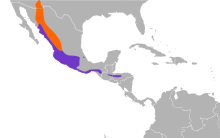Buff-collared nightjar
This article includes a list of general references, but it remains largely unverified because it lacks sufficient corresponding inline citations. (October 2009) |
| Buff-collared nightjar | |
|---|---|

| |
| Scientific classification | |
| Kingdom: | Animalia |
| Phylum: | Chordata |
| Class: | Aves |
| Order: | Caprimulgiformes |
| Family: | Caprimulgidae |
| Genus: | Antrostomus |
| Species: | A. ridgwayi
|
| Binomial name | |
| Antrostomus ridgwayi (Nelson, 1897)
| |

| |
| Synonyms | |
|
Caprimulgus ridgwayi | |
The buff-collared nightjar (Antrostomus ridgwayi) is a small nightjar. Adults are dark with brown, grey, black and white patterning on the upperparts and breast. The tail is dark brown, with darker finely barred markings throughout. The male has large white outer tail tips on the 3 outermost tail feathers. The female has buffy tail tips. These are most distinguishing characteristic to distinguish its identity from its closest relative the Whip-poor-will from where the bird gets its name. It shows a prominent buff-colored collar around its neck and nape. Its song is also very different. It sounds like an accelerating cuk, cuk, cuk, cuk, cuk, cukacheea.[2]
Their breeding habitat is open country of Mexico and Central America to central Nicaragua. The northern limit of its range reaches just over the Mexican border to southeasternmost Arizona and southwesternmost New Mexico–(the Madrean Sky Islands in the eastern Sonoran Desert mountain region), where they are the only breeding resident birds.[citation needed] The nightjar's two eggs are laid directly on bare ground near rocks or scrubby vegetation—there is no nest. The adult may feign injury to distract an intruder from the eggs or young birds.
They catch flying insects on the wing, making forays to catch their prey from the ground or a perch from a bush, tree, or large rock. They are mainly active at night, but can also be awake at dawn or dusk. They usually rest on the ground during the day.
Name[]
The buff-collared nightjar was previously known as Ridgway's whip-poor-will.[3] Its scientific name (Antrostomus ridgwayi) was chosen in honor of Robert Ridgway, an American ornithologist of the 19th century.
References[]
- ^ BirdLife International (2016). "Antrostomus ridgwayi". The IUCN Red List of Threatened Species. IUCN. 2016: e.T22689801A93248442. doi:10.2305/IUCN.UK.2016-3.RLTS.T22689801A93248442.en.
- ^ Dunn, Jon L. & Alderfer, Jonathan (2006). National Geographic Guide to the Birds of North America. National Geographic Society. ISBN 1-4262-0072-2.
- ^ Robbins, Chandler S.; Bruun, Bertel; Zim, Herbert S. (1966). A Guide to Field Identification – Birds of North America. New York: Western Publishing Company, Inc. p. 168.
External links[]
- Buff-collared Nightjar photo; Article siti.com
- Buff-collared Nightjar photo; Article -(Caprimulgus ridgwayi)
- RangeMaps & synopsis InfoNatura NatureServe
- Buff-collared Nightjar photo gallery VIREO Photo-High Res
- IUCN Red List least concern species
- Antrostomus
- Native birds of the Southwestern United States
- Birds of Central America
- Birds of Mexico
- Birds of Guatemala
- Birds of Honduras
- Birds of Nicaragua
- Birds described in 1897
- Taxa named by Edward William Nelson
- Birds of the Sierra Madre Occidental
